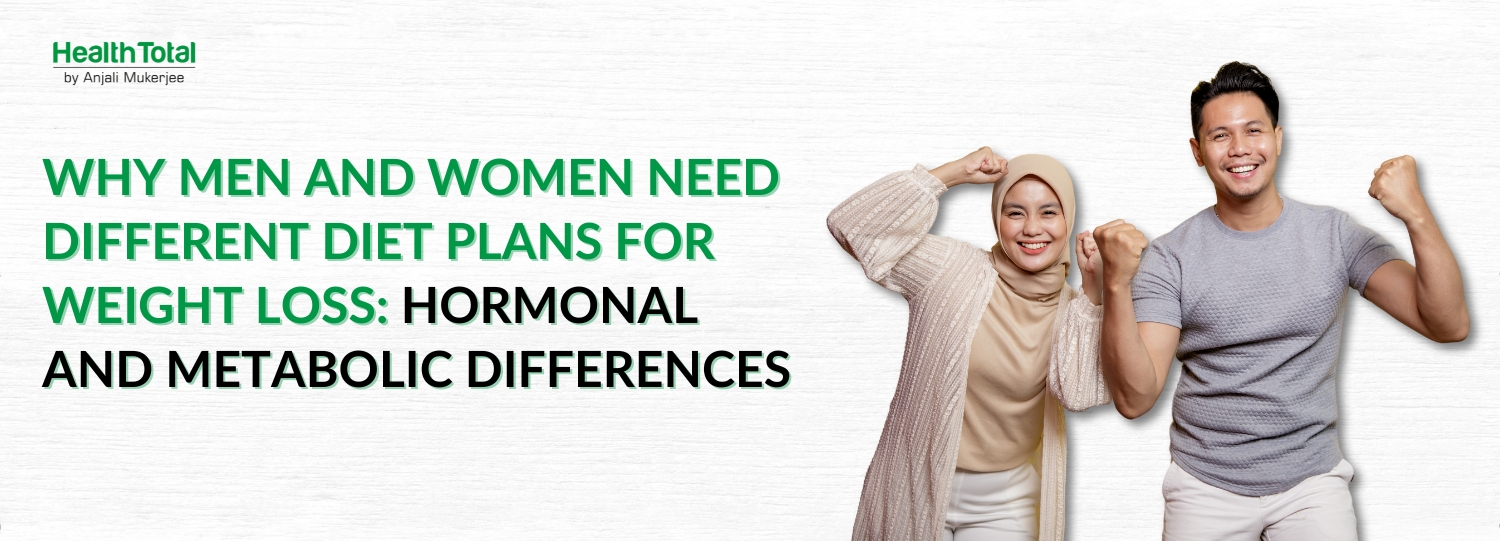
Why Men and Women Need Different Diet Plans for Weight Loss: Hormonal and Metabolic Differences
Many people want to lose weight, but men and women may experience the process very differently. These discrepancies are caused by changes in hormones, metabolism, and social roles. It can be easier to create individualized diet regimens that produce greater outcomes if you understand the subtle differences between how men and women lose weight. This blog will explore the reasons why men and women require different approaches to eating and offer suggestions for diets that work for both males and females.
The Science Behind Weight Loss Differences in Men and Women
Hormonal Influences
Hormones are essential for losing weight. Higher testosterone levels in men are often associated with greater muscular mass and a quicker metabolism. Contrarily, women’s increased estrogen levels encourage fat storage, particularly around the hips and thighs. Men often lose weight more quickly than women due to these hormonal variations, although women may experience particular difficulties such as hormonal changes during menstruation, pregnancy, and menopause.
Metabolic Rates
Due to their greater lean muscle mass, men often have a higher basal metabolic rate (BMR) than women. Men need more calories to maintain their weight because muscle burns more calories at rest than fat. When combined with an appropriate diet, this distinction makes it simpler for males to lose body fat.
Fat Distribution
Patterns of fat distribution also vary. Women typically store fat in their hips, thighs, and buttocks, but men typically store it in their abdomen. Because visceral fat, is more metabolically active and quicker to remove than subcutaneous fat, which is more common in women, this difference may affect how effective some fat-loss techniques are.
Diet Plans for Men to Lose Weight
A diet plan for men to lose weight should make use of their metabolic advantages while meeting their dietary requirements. This is a summary:
Macronutrient Focus
- High Protein: Protein aids with fat loss and muscle retention. Add fish, beans, tofu, eggs, and lean meats.
- Moderate Carbs: To maintain energy, choose complex carbs like sweet potatoes, whole grains, and legumes.
- Healthy Fats: For heart health and fullness, include foods like avocados, almonds, seeds, and olive oil.
Sample Fat Loss Diet Plan for Male
- Meal Food Items
Breakfast – Scrambled eggs (3), whole-grain toast, avocado
Snack – Greek yogurt with a handful of almonds
Lunch – Grilled chicken, quinoa, steamed broccoli
Snack – A protein shake or boiled eggs
Dinner – Grilled salmon, brown rice, sautéed spinach
- Portion Control and Timing
Men should pay attention to meal timing and food sizes. Overeating can be avoided and energy levels can be maintained by eating smaller, more frequent meals throughout the day. Another effective tactic for male fat loss is intermittent fasting.
Diet Charts for Women to Lose Weight
Women’s hormonal cycles and propensity for fat storage necessitate a more complex strategy. A diet chart for weight loss for females should promote fat reduction, regulate hormones, and avoid dietary deficits.
Nutritional Priorities
- Iron and Calcium: Calcium and iron are necessary for healthy bones and a healthy energy level. Add lentils, spinach, and dairy products that have been fortified.
- Complex Carbs: Sweet potatoes, oats, and whole grains provide you with long-lasting energy.
- Healthy Fats: Pay attention to foods high in omega-3, such as walnuts, fatty salmon, and flaxseeds.
- Protein: Aids in maintaining lean muscle mass while losing weight. Lean poultry, eggs, and beans are among the sources.
Sample Diet Chart to Lose Weight for Female
Meal Food Items
Breakfast – Oatmeal with fresh berries and almond milk
Snack – A handful of walnuts or a small apple
Lunch – Grilled chicken salad with olive oil dressing
Snack – A boiled egg or cucumber slices with hummus
Dinner – Lentil soup, quinoa, and steamed asparagus
Addressing Hormonal Changes
As women’s hormones alter during the menstrual cycle, they should modify their diet accordingly. For example:
- Pay attention to complex carbohydrates and lean proteins throughout the follicular phase.
- Foods high in magnesium, such as nuts and dark chocolate, can help reduce cravings during the luteal phase.
Weight Loss Diet Plan Chart: General Tips
Hydration
For both men and women, drinking enough water is essential. Maintaining proper hydration increases fat metabolism reduces appetite, and facilitates digestion.
Avoid Processed Foods
Processed foods are low in nutrients and high in calories. Swap them out for complete, nutrient-dense foods to properly fuel your body.
Incorporate Fiber
Include Fiber Vegetables, fruits, and legumes are important components of any weight loss diet plan since they increase satiety and facilitate better digestion.
Exercise Integration
Diet is insufficient on its own. A goal-oriented fitness program combined with a healthy diet can greatly accelerate weight loss attempts.
Challenges in Weight Loss for Men and Women
For Men
- Overuse of supplements or protein drinks
- Ignoring deficits in micronutrients
- Consuming too many calories as a result of poor portion control
For Women
- Hormonal changes that result in cravings
- Pressures from society and irrational expectations
- Deficits in nutrients caused by restricted diets
Crafting Sustainable Diet Plans
Sustainability is essential. Although crash diets can produce rapid results, they are rarely sustainable and can have negative long-term health effects. Rather, concentrate on:
- Realistic Goals: Aim for a weekly weight loss of 1-2 pounds.
- Balanced Meals: A combination of macro and micronutrients should be included in balanced meals.
- Consistency: Even during stressful times or holidays, follow the plan.
Personalizing Diet Plans
Everybody is different. Personalized programs provide the best results, although generic recommendations can be helpful. Think about things like:
- Activity Levels: More active People could require more calories.
- Age: As people age, their nutritional demands vary.
- Health Conditions: Special care is needed for conditions like diabetes or hypothyroidism.
Conclusion
Developing successful weight loss diet regimens requires an understanding of the physiological distinctions between men and women. Men gain by having more muscular mass and a greater metabolic rate, but women have particular difficulties because of hormonal changes. Both sexes can reach their weight loss goals by emphasizing a customized diet, reasonable aims, and long-lasting behaviours. Balance, consistency, and individuality are crucial when it comes to diet plans for men to lose weight or a diet chart for weight loss for females, whether they are for men or women. Make wise choices and put in consistent effort to start your path to a healthier self.
